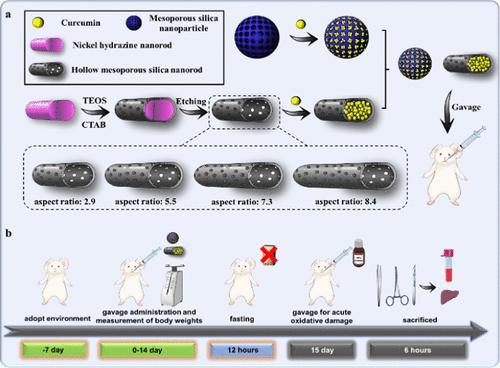不同形态介孔二氧化硅纳米材料的口服姜黄素:合成、表征、生物安全性评价和体内抗氧化活性
IF 3.9
2区 化学
Q2 CHEMISTRY, MULTIDISCIPLINARY
引用次数: 0
摘要
抗氧化剂在预防和治疗与氧化应激相关的疾病中起着至关重要的作用。姜黄素(Curcumin, CUR)是一种天然抗氧化剂,具有抗氧化、抗炎、抗菌和抗肿瘤等多种治疗作用。然而,其有限的生物利用度和较差的水溶性阻碍了其作为有效抗氧化剂的应用。本研究采用模板-沉积-蚀刻法合成了一系列具有不同形貌的介孔二氧化硅纳米材料,即介孔二氧化硅纳米颗粒(MSN)和介孔二氧化硅纳米棒(MSR)。我们选择CUR作为模型药物,并将其包裹在这些纳米材料中,以提高其体内的生物利用度。通过透射电子显微镜(TEM)成像和Zetasizer分析确定了MSN和MSR的形貌和尺寸分布。傅里叶变换红外光谱(FTIR)证实了在这些纳米材料内成功封装CUR。此外,这些负载cur的二氧化硅纳米材料(表示为CUR@MSN和CUR@MSR)在体外表现出优异的DPPH和ABTS自由基清除活性。此外,CUR@MSN和CUR@MSR也表现出明显的体内抗氧化活性。本研究为利用介孔二氧化硅纳米材料开发增强型抗氧化剂开辟了新的途径。本文章由计算机程序翻译,如有差异,请以英文原文为准。

Oral Curcumin through Mesoporous Silica Nanomaterials with Distinct Morphologies: Synthesis, Characterization, Biosafety Evaluation, and Antioxidant Activity In Vivo
Antioxidant play a crucial role in the prevention and treatment of diseases associated with oxidative stress. Curcumin (CUR), as a natural antioxidant, exhibits numerous therapeutic properties, including antioxidant, anti-inflammatory, antibacterial, and antitumor activities. However, its limited bioavailability and poor water solubility hinder its application as an effective antioxidant. In this study, a series of mesoporous silica nanomaterials with distinct morphologies, i.e., mesoporous silica nanoparticles (MSN) and mesoporous silica nanorods (MSR) were synthesized by a template–sediment–etching method. CUR was selected as a model drug and encapsulated into these nanomaterials to improve its bioavailability in vivo. The morphology and size distribution of MSN and MSR were determined through transmission electron microscopy (TEM) imaging and Zetasizer analysis. Fourier transform infrared spectroscopy (FTIR) spectra confirmed the successful encapsulation of CUR within these nanomaterials. Furthermore, these CUR-loaded silica nanomaterials, denoted as CUR@MSN and CUR@MSR, exhibited excellent DPPH and ABTS free radical scavenging activity in vitro. Furthermore, CUR@MSN and CUR@MSR also exhibited obvious in vivo antioxidant activity. This study opens up new avenues for the development of enhanced antioxidants through the utilization of mesoporous silica nanomaterials.
求助全文
通过发布文献求助,成功后即可免费获取论文全文。
去求助
来源期刊

Langmuir
化学-材料科学:综合
CiteScore
6.50
自引率
10.30%
发文量
1464
审稿时长
2.1 months
期刊介绍:
Langmuir is an interdisciplinary journal publishing articles in the following subject categories:
Colloids: surfactants and self-assembly, dispersions, emulsions, foams
Interfaces: adsorption, reactions, films, forces
Biological Interfaces: biocolloids, biomolecular and biomimetic materials
Materials: nano- and mesostructured materials, polymers, gels, liquid crystals
Electrochemistry: interfacial charge transfer, charge transport, electrocatalysis, electrokinetic phenomena, bioelectrochemistry
Devices and Applications: sensors, fluidics, patterning, catalysis, photonic crystals
However, when high-impact, original work is submitted that does not fit within the above categories, decisions to accept or decline such papers will be based on one criteria: What Would Irving Do?
Langmuir ranks #2 in citations out of 136 journals in the category of Physical Chemistry with 113,157 total citations. The journal received an Impact Factor of 4.384*.
This journal is also indexed in the categories of Materials Science (ranked #1) and Multidisciplinary Chemistry (ranked #5).
 求助内容:
求助内容: 应助结果提醒方式:
应助结果提醒方式:


